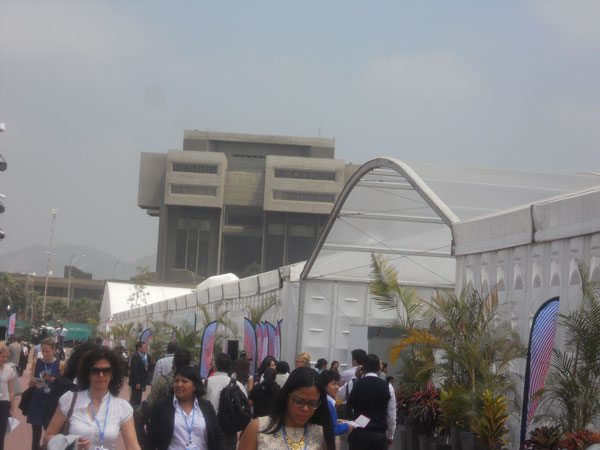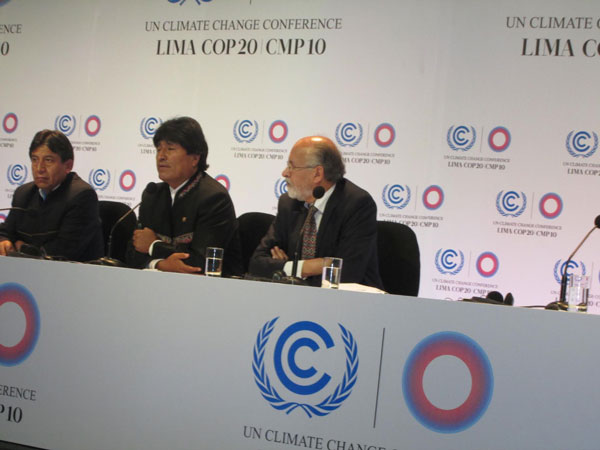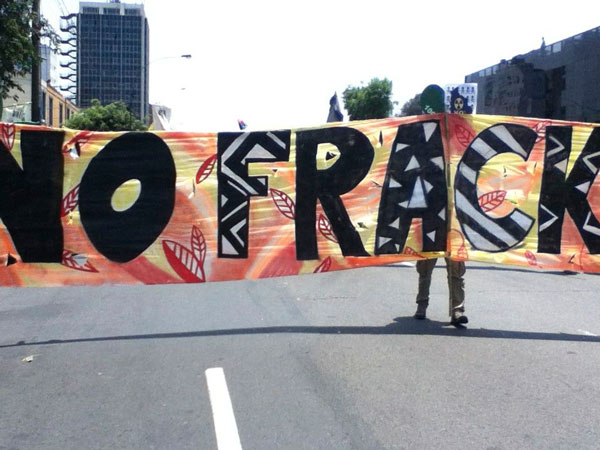Report #4
Winter Solstice, 2014
By David Simpson and Jane Lapiner
Overview (Ambition Versus the Low Carbon Economy: In Lima with the UN, 2014)
Photo library at bottom.
Recently returned from the desert shoreline of sub-equatorial Peru where it rarely rains, we arrived back to the deep green of a North Coast rainy season wet enough in its first half to put our part of California’s record drought at least temporarily at bay. Lima was the scene for the first two weeks in December of humankind’s–or at least civilizations’–annual stab at answering the gravest question ever put to it. How can we slow accelerating climate change enough to assure our societies will survive?
The mission of the United Nations’ climate secretariat, called the UN Framework Convention on Climate Change (UNFCCC), is to organize negotiations between 196 nations around this question. The annual two week discussions known as the Conferences of the Parties or COPs, was initiated in l995. This COP, held at a huge park-like military preserve—the Pentagonito–in the middle of Lima, was the 20th.
The COP process seems on the surface an ornate, measured dance between cooperating countries or “Parties”. Not far beneath, though, the guise of civility wears thin. It is there that fault lines related to a history of colonialism, exploitation and market competition begin to shift and the inequities inherent in the playing out of imbalanced national self-interests come to dominate relationships between countries.
The foundation for this event was, as usual, the science. The science of climate change and the human role in it are no longer in question in any circles where the earth is recognized as round. The UN’s science component, the Inter-governmental Panel on Climate Change, released its fifth “Assessment Report” of its 25 year existence just before COP 20. The news was indeed grim; 2014 was proving to be the warmest year since recordkeeping began in 1880. World average temperatures are currently on a trajectory to rise high above the already questionable 2 ° C increase that had been officially accepted by the UNFCCC at COP 17 as the greatest extent of heating that can be tolerated by society. (1.5° C is on the verge of becoming the new universal target as the severe impacts of only a 1° F rise (.55° C) in world average temperatures have already been cruelly felt.)
Many of us can utter by heart litanies of recent climate-related disasters—massive storms, vast landscapes altered by drought, melting sea ice and glaciers, species disappearing and on. We know less clearly, however, what to do in response. We seem to be at war with ourselves, caught between the desire for more development–including development that would reduce crushing poverty–and the need to avoid super-heating the atmosphere. Must we all lose for the winning?
Given this accelerated time-frame of planetary loss, how do we scale up our still-puny efforts at survival? Organizing an administrative path so that these questions could ostensibly be answered in Paris next December was the mission of the Lima COP. It is in Paris that the essential task of establishing the goals and targets of a new emissions reduction period will be completed. Many scientists and long-time activists believe that this is the make-or-break moment for the species, the last opportunity to substantially challenge climate change. And they are the optimists!
One crucial term frequently heard discussed in Lima was the “carbon bubble”. If all of the known reserves of fossil fuel are burned, resulting CO2 emissions would cause the atmosphere to be warmed far in excess of the perceived maximum survivable world temperature rise—the 1.5 or 2°C. Avoiding such disaster requires that we keep almost 80% of these reserves in the ground. Reserves, of course, which form the basis of value for the fossil fuel industries. If they are to be “stranded”–made unusable by regulations intended to keep within targeted temperature levels–the stock value of these mega-corporations could decline radically; thus the bubble.
The fact that the Bank of England recently launched a study to determine whether or not fossil fuels represent a major threat to the world economy emphasizes how close we may be to a momentous turning point. The fossil fuel corporations deny how close to the edge we are, of course, but the situation seems to be starkly simple. Either we allow the burning of fossil fuels to further destroy the health and productivity of the planet or we transcend the need for those fuels altogether. This would require that we pinch our noses and leap whole hog into a commitment to achieve a 0 carbon energy future as quickly as we can.
There was practically no one in attendance in Lima who did not credit the idea that the 0 carbon economy was coming at some point. The only real question was when. There were 0 carbon energy supporters in some numbers who insisted that we are much closer to being able to transfer our energy production to clean sources than we are allowed to think. Others feel themselves to be more hard-headed and aware of the distances we must travel and the rock-hard challenges along the road.
Knowing, though, that we are on the approach to a zero carbon economy is essential in several respects. One of the gravest threats we face carbon-wise comes through that urgent need for development in poorer countries to help their populations climb out of brutalizing poverty. Their valid demands for a large share of the remaining space in the atmosphere for emissions could push us all over the edge unless these societies are able to leap beyond fossil fuel-based infrastructure development and move immediately toward renewables. This they can only do with a great amount of assistance.
The UNFCCC process, unfortunately, seems resistant to ambition. It seems to amble without haste toward a middle ground–the safer alternative of a “low carbon future”. This “future” itself arrives via two different routes, both beset with problems. Either we fall back on a combination of lower-carbon fuels and those that are carbon-free but still dangerous or we go on using conventional fuels rendered less carbon intensive through application of new, unproven technologies.
Coal still dominates world energy production but is the dirtiest fuel. Nuclear power has proven to present its own grave existential threat. The other major coal-replacing fuel, natural gas, or methane, burns cleaner but incidentally releases methane into the atmosphere. Methane is second only to CO2 as a dangerous greenhouse gas. More important, natural gas production on the scale this model needs requires widespread fracking and all that goes with it.
The second potential route toward the low carbon model still relies on burning oil and especially coal, but this time the industry claims it is “low-carbon”. They claim to be able to achieve this on a gigantic scale through a technology called Carbon Capture and Storage or CCS.
CCS is the new white knight riding in to save the industry. It requires pumping carbon emissions, either in gaseous form or liquid, into cavernous holes in the ground many of which were depleted oil or even coal reservoirs. Both getting it to the holes and guaranteeing that the gas or liquid stays there far into the future requires technological competence on a scale we’ve never yet achieved. Like “spent” but still lethal nuclear fuels, these CO2 storage vaults will require constant monitoring in a temporal frame that has no discernible end point, i.e. forever.
CCS might be better lumped into the category of “Geo engineering”. This is the Strangelovian sub-group of climate solutions that are distinguished by their gargantuan size, uncertain outcome and massive expense; using giant cannons, for instance, to shoot ice crystals into the polar stratosphere in order to deflect sunlight, or salting the ocean with basic compounds on the scale necessary to counter increasing acidity.
The CCS promoters, struggling to perpetuate their dominance, say little about unintended consequences. They admit, though, that even if it all worked, somehow, the percentage of savings over plain old “dirty” coal-fired plants would be a maximum of 17 %–not insignificant, certainly, but not nearly enough.
Thus without easy access to natural gas, without being haunted by a constant nuclear menace or without the application of highly unlikely mega-technologies to clean up dirty old King Coal, the industrial revolution that created modern society will draw quickly to a close. Though the rapidly growing divestiture movement might prod them closer to the edge, it will be the internal contradictions of fossil fuel burning as the foundation for civilization that finally propels the coal, oil and gas industries over the precipice. Any threat of new regulation or curtailment of subsidies to fossil fuel producers has the capacity to send the market spinning into dithering insecurity.
As one might suspect, these industries are not prepared simply to relinquish their enormous power and have already launched a new PR campaign. Only through the burning of coal and/or natural gas, their argument now goes, will we be able to sustain the continued rise of the world’s poor into the new global middle class. In one quick hop, the same companies that have famously despoiled ecosystems and ruined indigenous or land-based communities in places like the Niger River Delta, Appalachia, the Ecuadorean Amazon or even the Gulf of Mexico are now asking us to accept a new vision of themselves as principled enablers of the march out of poverty.
Scheduled to be completed at the end of the day on Friday, COP 20 ran into early Sunday morning before an agreement was cobbled together. In it, vital concerns of developing countries were paid only lip-service. Actions favored by the powerful had higher priority. Overall, a sense of the urgency which the science clearly calls for was sorely lacking.
Leadership dealt with this void by once again, as in past COPs, giving the document that wrapped up the “accomplishments” of the event a high-sounding title: “The Lima Call to Climate Action”. Finally, they congratulated themselves warmly and did what by that time they really wanted to do– go home, however more vulnerable their homes had become because of the job left undone. Large segments in the fabric of the climate enterprise were left unsewn and the questions science so fervently asked went unanswered. As if they had all the time in the world.
As for the US, it’s hard to accept the testimony of your senses. In a passionate speech two days before the conclusion of the event Secretary of State John Kerry gave a laudably impassioned and informed speech about climate change. Among other statements was this, “An ambitious agreement in Paris is not an option, it’s an urgent necessity.”
During the next two days, when his State Department negotiating team became an obstacle to the COP closing with anything resembling an ambitious statement or plan, one could easily feel unmoored. There was an obvious and large disconnect. Was Kerry not really in charge of Special Envoy Todd Stern and the US negotiating team? If not, who was? Perhaps Kerry was manifesting a political culture whose primary mode was strong speeches with no compulsion to follow up with action. Was I just naïve or had politics in the Obama era slipped ever deeper into a new kind of ethical void?
It was hard not to recall Hilary Clinton in the same State position, same UNFCCC press conference but this time in Copenhagen 2009 when she pronounced with the certainty of unassailable power that the US was taking part in establishing a global climate fund. This fund would bring 100 billion dollars per year to poor countries to help them adapt to climate change or install clean energy technology by 2020. At this date, five COP’s later, the “Green Climate” Fund has a total of 13 billion in it, all in one-time donations, only three billion from the US.
What of the UN? If there was corruption or lack of ambition among nations that slowed negotiations without any assignment of responsibility for the damage that the delays might cause, was the UN complicit? Was it putting the world at ever graver risk by letting the nations get away with very bad behavior? Or was it buffaloed too by the big energy corporations?
The Nations! Sometimes they seem in this process little more than loosely conglomerated hunting packs, private interests with a token government adjunct, their original insufficient regard for real natural and cultural boundaries limiting their capacity for right action from the start.
Beneath a diplomatic veneer, the nations were engaged in a free-for-all as the climate steamroller bears down on them all: the well-off work to preserve prerogatives without appearing to be bullies or deniers; the poor struggle just to keep their noses above water; and the new in-betweeners—like China, India and Brazil with their rapidly rising middle classes seem determined to maintain a position which allows them the benefits of both definitions, rich and poor, developing and developed. Vulnerable sovereignties constantly jockey for position against easily bruised dignities while the truly powerful among them claim the most “territory”, both atmospheric and market-wise. The UN with its limited authority could only dash around like a harried matron aunt without much power in the family trying to cajole a bunch of surly teenaged siblings to stop their brawling and take care of business.
The ultimate duplicity, in my estimate, was reserved for the one Lord amongst us, Lord Nicholas Stern, famed British climate economist who has a provenance of epic dimension that begins with the London School of Economics. He led off a seminar in Lima at the pavilion of the IETA, International Emissions Trading Association. These are the same old carbon traders who seem to provide annually a cozy little den where jocular corporate hardballers and private enterprise acolytes take refuge from a convention campus dominated by straight-laced public sector types.
Led by amiable salesman Dirke Forrister, former chairman of Clinton’s Climate Change Task Force, IETA carries a lot of water for corporate forces. The panel discussion, in addition to Stern, included Shell’s chief environmental officer, the current CEO of SaskPower, a large Canadian energy producer and several other high level energy corporation managers. The subject at hand was originally encapsulated in a long title, “Why wait to implement a Zero Carbon economy in the future when we can have a low carbon economy right now.”
Stern’s brief talk led off what was basically an oil company love fest by paying tribute to the advent of CCS, the new holy grail of the carbon masters. As one after another of the speakers followed suit, the implication was that CCS was a done deal, an effectively functioning technology that would extend the life of coal-burning power production. Just how important this almost mythical process was to the industry became quite clear.
It was Lord Stern’s choice of words in a press release issued right after COP 20 closed that struck one dumb. After lauding the conference, its summary statement and its Peruvian organizers, he concluded, “However, it is already clear that the scale of action to control and reduce annual emissions of greenhouse gases will collectively not be consistent with a pathway that will mean a reasonable chance of avoiding dangerous global warming of more than 2°C above pre-industrial levels.”
In other words, we’re on a roll toward disaster. But thank God there is one elastic element, Time. And what is buying us that Time?
CCS or maybe the possibility that we might be able to cannonade climate change out of existence with a big enough gun?
Stern went on, “That means countries must continue to explore opportunities to increase emissions cuts. And they must build into the Paris agreement arrangements for moving purposefully thereafter to increase the scale of action.” The thereafter is what really hurts. Why thereafter in Paris in December? Why not thereafter that very moment in Lima ? Why hadn’t it been thereafter in Copenhagen or even Kyoto? What have we been doing for the past twenty years? Cutting enough emissions had been the ‘purpose’ of the whole thing from the start, right?
Or had it? Why was it that Stern and company seemed quite content to concede defeat before the battle? Why concede imminent, short-term defeat unless of course there was more benefit, i.e. profit, in the delay? Otherwise why even pretend to fight? What does it take to light a fire of real urgency under these people? So many questions.
In face of the one unquestionable element, the science, a message to take away from Lima is that lack of urgency is another form of climate denial and potentially just as fatal as the brand Senator Inhoff is still trying to sell.
Negotiations are scheduled to resume on a smaller scale in Geneva in February and then Bonn in March in preparation for COP 21 in Paris in December. The UN has just established a registry for Paris in which each country is expected to enter their Intended Nationally Determined Commitment for voluntary, as opposed to mandatory, emissions reductions and assistance to developing countries. Questions of equity and Common but Differentiated Responsibilities—who owes who to pay for what—will be answered…or not.
Directives after Lima
What specific guidelines or functional wisdom might we in Northern California draw from the experience and current state of the UNFCCC process? A few things suggest themselves. One is to keep doing what we’re doing. Local public and private clean energy, conservation and ecosystem restoration initiatives can and do play out positively for our economy and the environment. We need to step up the level of activity and define new areas where progress might be made especially in light of the State of California’s emerging new energy initiatives. We also need to move past our individual comfort zones and be willing to challenge misinformation about climate science when it pops up.
All this should not be interpreted as an abandonment of the highest level of societal organizing, the Federal government and the United Nations. The enormous march in New York last September rang a lot of bells. Massive public expressions of our desire to survive must be thrown up against the remaining walls of ignorance in government and industry and against progress-killing lack of ambition. How big do the storms have to get, how deep the droughts?
click on photos for larger images


Previous: Lima (COP20) Report #3







Thanks for sharing. I read many of your blog posts, cool, your blog is very good.